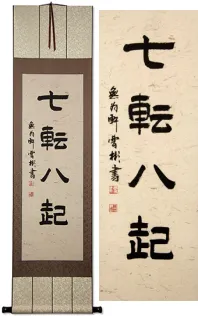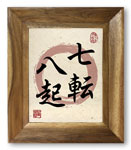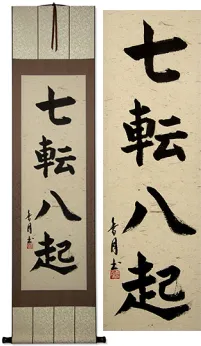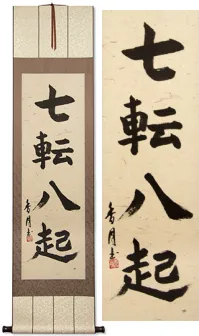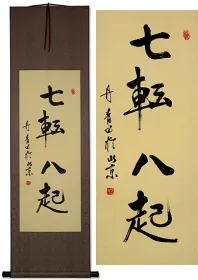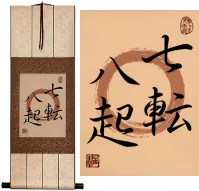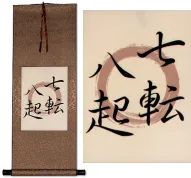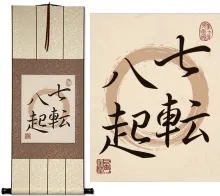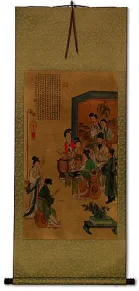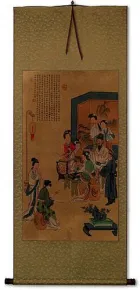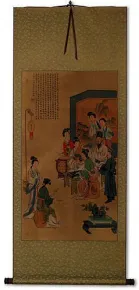Many custom options...
And formats...

The name Number Seven in Chinese / Japanese...
Buy a Number Seven calligraphy wall scroll here!
Seven
The number seven
七 is the number 7 in Chinese, Korean Hanja, and Japanese Kanji. I have no idea why you would want this as a calligraphy wall scroll but hundreds of visitors search for this number.
In Japanese, this character can be pronounced several different ways depending on context. It can be shichi / nana-, and a few others when combined with other characters.
There's just one way to pronounce this in Chinese. Korean also has just one pronunciation.
This in-stock artwork might be what you are looking for, and ships right away...
Gallery Price: $180.00
Your Price: $99.88
Gallery Price: $222.00
Your Price: $122.88
Gallery Price: $222.00
Your Price: $122.88
Gallery Price: $100.00
Your Price: $49.88
Gallery Price: $100.00
Your Price: $49.88
Gallery Price: $100.00
Your Price: $39.88
Gallery Price: $100.00
Your Price: $58.88
Gallery Price: $100.00
Your Price: $58.88
Gallery Price: $200.00
Your Price: $79.88
Not the results for number seven that you were looking for?
Below are some entries from our dictionary that may match your number seven search...
| Characters If shown, 2nd row is Simp. Chinese |
Pronunciation Romanization |
Simple Dictionary Definition |
佛 see styles |
fó fo2 fo hotoke ほとけ |
More info & calligraphy: Buddhism / Buddha(surname) Hotoke Buddha, from budh to "be aware of", "conceive", "observe", "wake"; also 佛陀; 浮圖; 浮陀; 浮頭; 浮塔; 勃陀; 勃馱; 沒馱; 母馱; 母陀; 部陀; 休屠. Buddha means "completely conscious, enlightened", and came to mean the enlightener. he Chinese translation is 覺 to perceive, aware, awake; and 智 gnosis, knowledge. There is an Eternal Buddha, see e.g. the Lotus Sutra, cap. 16, and multitudes of Buddhas, but the personality of a Supreme Buddha, an Ādi-Buddha, is not defined. Buddha is in and through all things, and some schools are definitely Pan-Buddhist in the pantheistic sense. In the triratna 三寳 commonly known as 三寳佛, while Śākyamuni Buddha is the first "person" of the Trinity, his Law the second, and the Order the third, all three by some are accounted as manifestations of the All-Buddha. As Śākyamuni, the title indicates him as the last of the line of Buddhas who have appeared in this world, Maitreya is to be the next. As such he is the one who has achieved enlightenment, having discovered the essential evil of existence (some say mundane existence, others all existence), and the way of deliverance from the constant round of reincarnations; this way is through the moral life into nirvana, by means of self-abnegation, the monastic life, and meditation. By this method a Buddha, or enlightened one, himself obtains Supreme Enlightenment, or Omniscience, and according to Māhāyanism leads all beings into the same enlightenment. He sees things not as they seem in their phenomenal but in their noumenal aspects, as they really are. The term is also applied to those who understand the chain of causality (twelve nidānas) and have attained enlightenment surpassing that of the arhat. Four types of the Buddha are referred to: (1) 三藏佛the Buddha of the Tripiṭaka who attained enlightenment on the bare ground under the bodhi-tree; (2) 通佛the Buddha on the deva robe under the bodhi-tree of the seven precious things; (3) 別佛the Buddha on the great precious Lotus throne under the Lotus realm bodhi-tree; and (4) 圓佛the Buddha on the throne of Space in the realm of eternal rest and glory where he is Vairocana. The Hīnayāna only admits the existence of one Buddha at a time; Mahāyāna claims the existence of many Buddhas at one and the same time, as many Buddhas as there are Buddha-universes, which are infinite in number. |
七難 七难 see styles |
qīn án qin1 an2 ch`in an chin an shichinan しちなん |
(1) {Buddh} the Seven Misfortunes; (2) great number of faults or defects The seven calamities in the仁王經, 受持品 during which that sūtra should be recited: sun and moon losing their order (eclipses), conste11ations, irregular, fire, flood, wind-storms, drought, brigands Another set is — pestilence, invasion, rebe11ion, unlucky stars, eclipses, too early monsoon, too late monsoon. Another is — fire, flood, rakṣas, misrule, evil spirits, cangue and prison, and robbers. |
名数 see styles |
meisuu / mesu めいすう |
(1) {math} (See 無名数) concrete number; denominate number; (2) (See 三筆,四天王・1) numbered group of related things or people (e.g. seven wonders of the world) |
四禪 四禅 see styles |
sì chán si4 chan2 ssu ch`an ssu chan shizen |
(四禪天) The four dhyāna heavens, 四靜慮 (四靜慮天), i. e. the division of the eighteen brahmalokas into four dhyānas: the disciple attains to one of these heavens according to the dhyāna he observes: (1) 初禪天 The first region, 'as large as one whole universe' comprises the three heavens, Brahma-pāriṣadya, Brahma-purohita, and Mahābrahma, 梵輔, 梵衆, and 大梵天; the inhabitants are without gustatory or olfactory organs, not needing food, but possess the other four of the six organs. (2) 二禪天 The second region, equal to 'a small chiliocosmos' 小千界, comprises the three heavens, according to Eitel, 'Parīttābha, Apramāṇābha, and Ābhāsvara, ' i. e. 少光 minor light, 無量光 infinite light, and 極光淨 utmost light purity; the inhabitants have ceased to require the five physical organs, possessing only the organ of mind. (3) 三禪天 The third region, equal to 'a middling chiliocosmos '中千界, comprises three heavens; Eitel gives them as Parīttaśubha, Apramāṇaśubha, and Śubhakṛtsna, i. e. 少淨 minor purity, 無量淨 infinite purity, and 徧淨 universal purity; the inhabitants still have the organ of mind and are receptive of great joy. (4) 四禪天 The fourth region, equal to a great chiliocosmos, 大千界, comprises the remaining nine brahmalokas, namely, Puṇyaprasava, Anabhraka, Bṛhatphala, Asañjñisattva, Avṛha, Atapa, Sudṛśa, Sudarśana, and Akaniṣṭha (Eitel). The Chinese titles are 福生 felicitous birth, 無雲 cloudless, 廣果 large fruitage, 無煩 no vexations, atapa is 無熱 no heat, sudṛśa is 善見 beautiful to see, sudarśana is 善現 beautiful appearing, two others are 色究竟 the end of form, and 無想天 the heaven above thought, but it is difficult to trace avṛha and akaniṣṭha; the inhabitants of this fourth region still have mind. The number of the dhyāna heavens differs; the Sarvāstivādins say 16, the 經 or Sutra school 17, and the Sthavirāḥ school 18. Eitel points out that the first dhyāna has one world with one moon, one mem, four continents, and six devalokas; the second dhyāna has 1, 000 times the worlds of the first; the third has 1, 000 times the worlds of the second; the fourth dhyāna has 1, 000 times those of the third. Within a kalpa of destruction 壞劫 the first is destroyed fifty-six times by fire, the second seven by water, the third once by wind, the fourth 'corresponding to a state of absolute indifference' remains 'untouched' by all the other evolutions; when 'fate (天命) comes to an end then the fourth dhyāna may come to an end too, but not sooner'. |
假分數 假分数 see styles |
jiǎ fēn shù jia3 fen1 shu4 chia fen shu |
improper fraction (with numerator ≥ denominator, e.g. seven fifths); see also: proper fraction 真分數|真分数[zhen1 fen1 shu4] and mixed number 帶分數|带分数[dai4 fen1 shu4] |
贍部洲 赡部洲 see styles |
shàn bù zhōu shan4 bu4 zhou1 shan pu chou senbushū |
Jambudvīpa. Name of the southern of the four great continents, said to be of triangular shape, and to be called after the shape of the leaf of an immense Jambu-tree on Mount Meru, or after fine gold that is found below the tree. It is divided into four parts: south of the Himālayas by the lord of elephants, because of their number; north by the lord of horses; west by the lord of jewels; east by the lord of men. This seems to imply a region larger than India, and Eitel includes in Jambudvīpa the following countries around the Anavatapta lake and the Himālayas. North: Huns, Uigurs, Turks. East: China, Corea, Japan, and some islands. South: Northern India with twenty-seven kingdoms, Eastern India ten kingdoms, Southern India fifteen kingdoms, Central India thirty kingdoms. West: Thirty-four kingdoms. |
七摩怛里 see styles |
qī mó dá lǐ qi1 mo2 da2 li3 ch`i mo ta li chi mo ta li shichi matari |
saptamātṛ. The seven divine mothers, or personified energies of the principal deities; they are associated with the worship of the god Śiva, and attend on his son Skanda or Kārttikeya, to whom at first only seven Mātṛs were assigned, but in the later mythology an innumerable number, who are sometimes represented as having displaced the original divine mothers M.W. Their names are given as (1) Cāmuṇḍā 遮文茶 or 左問拏 (2) Gaurī嬌吠哩; (3) Vaiṣṇavī 吠瑟拏微 (4) Kaumārī 嬌麼哩; (5) Indrāṇī, Aindrī, or Māhendrī 燕捺利 or 印捺哩; (6) Raudrī 勞捺哩; and (7) Vārāhī 末羅呬弭; cf. 七母天. |
The following table may be helpful for those studying Chinese or Japanese...
| Title | Characters | Romaji (Romanized Japanese) | Various forms of Romanized Chinese | |
| Seven | 七 | shichi / nana- | qī / qi1 / qi | ch`i / chi |
Successful Chinese Character and Japanese Kanji calligraphy searches within the last few hours...

